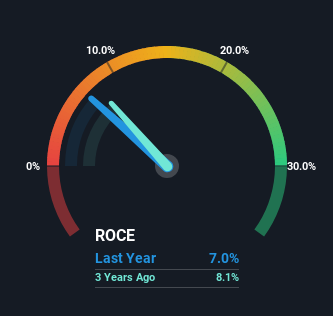UniFirst (NYSE:UNF) Will Be Hoping To Turn Its Returns On Capital Around
There are a few key trends to look for if we want to identify the next multi-bagger. Typically, we'll want to notice a trend of growing return on capital employed (ROCE) and alongside that, an expanding base of capital employed. Basically this means that a company has profitable initiatives that it can continue to reinvest in, which is a trait of a compounding machine. However, after investigating UniFirst (NYSE:UNF), we don't think it's current trends fit the mold of a multi-bagger.
Understanding Return On Capital Employed (ROCE)
For those that aren't sure what ROCE is, it measures the amount of pre-tax profits a company can generate from the capital employed in its business. To calculate this metric for UniFirst, this is the formula:
Return on Capital Employed = Earnings Before Interest and Tax (EBIT) ÷ (Total Assets - Current Liabilities)
0.07 = US$164m ÷ (US$2.6b - US$263m) (Based on the trailing twelve months to February 2024).
Thus, UniFirst has an ROCE of 7.0%. In absolute terms, that's a low return and it also under-performs the Commercial Services industry average of 10%.
See our latest analysis for UniFirst
Above you can see how the current ROCE for UniFirst compares to its prior returns on capital, but there's only so much you can tell from the past. If you'd like, you can check out the forecasts from the analysts covering UniFirst for free.
How Are Returns Trending?
On the surface, the trend of ROCE at UniFirst doesn't inspire confidence. Around five years ago the returns on capital were 11%, but since then they've fallen to 7.0%. Although, given both revenue and the amount of assets employed in the business have increased, it could suggest the company is investing in growth, and the extra capital has led to a short-term reduction in ROCE. And if the increased capital generates additional returns, the business, and thus shareholders, will benefit in the long run.
Our Take On UniFirst's ROCE
In summary, despite lower returns in the short term, we're encouraged to see that UniFirst is reinvesting for growth and has higher sales as a result. In light of this, the stock has only gained 2.2% over the last five years. So this stock may still be an appealing investment opportunity, if other fundamentals prove to be sound.
UniFirst could be trading at an attractive price in other respects, so you might find our free intrinsic value estimation for UNF on our platform quite valuable.
For those who like to invest in solid companies, check out this free list of companies with solid balance sheets and high returns on equity.
Have feedback on this article? Concerned about the content? Get in touch with us directly. Alternatively, email editorial-team (at) simplywallst.com.
This article by Simply Wall St is general in nature. We provide commentary based on historical data and analyst forecasts only using an unbiased methodology and our articles are not intended to be financial advice. It does not constitute a recommendation to buy or sell any stock, and does not take account of your objectives, or your financial situation. We aim to bring you long-term focused analysis driven by fundamental data. Note that our analysis may not factor in the latest price-sensitive company announcements or qualitative material. Simply Wall St has no position in any stocks mentioned.

 Yahoo Finance
Yahoo Finance 
